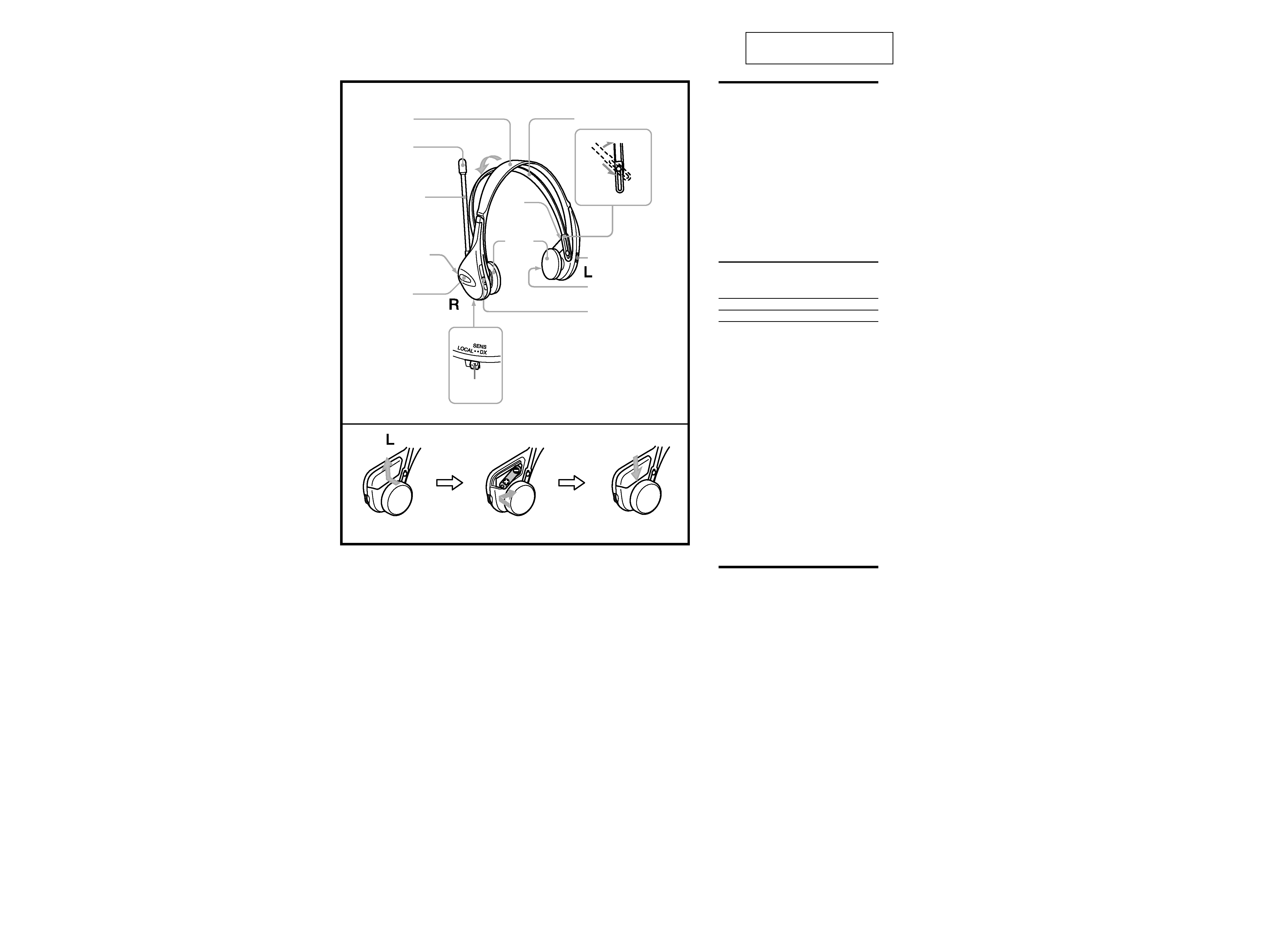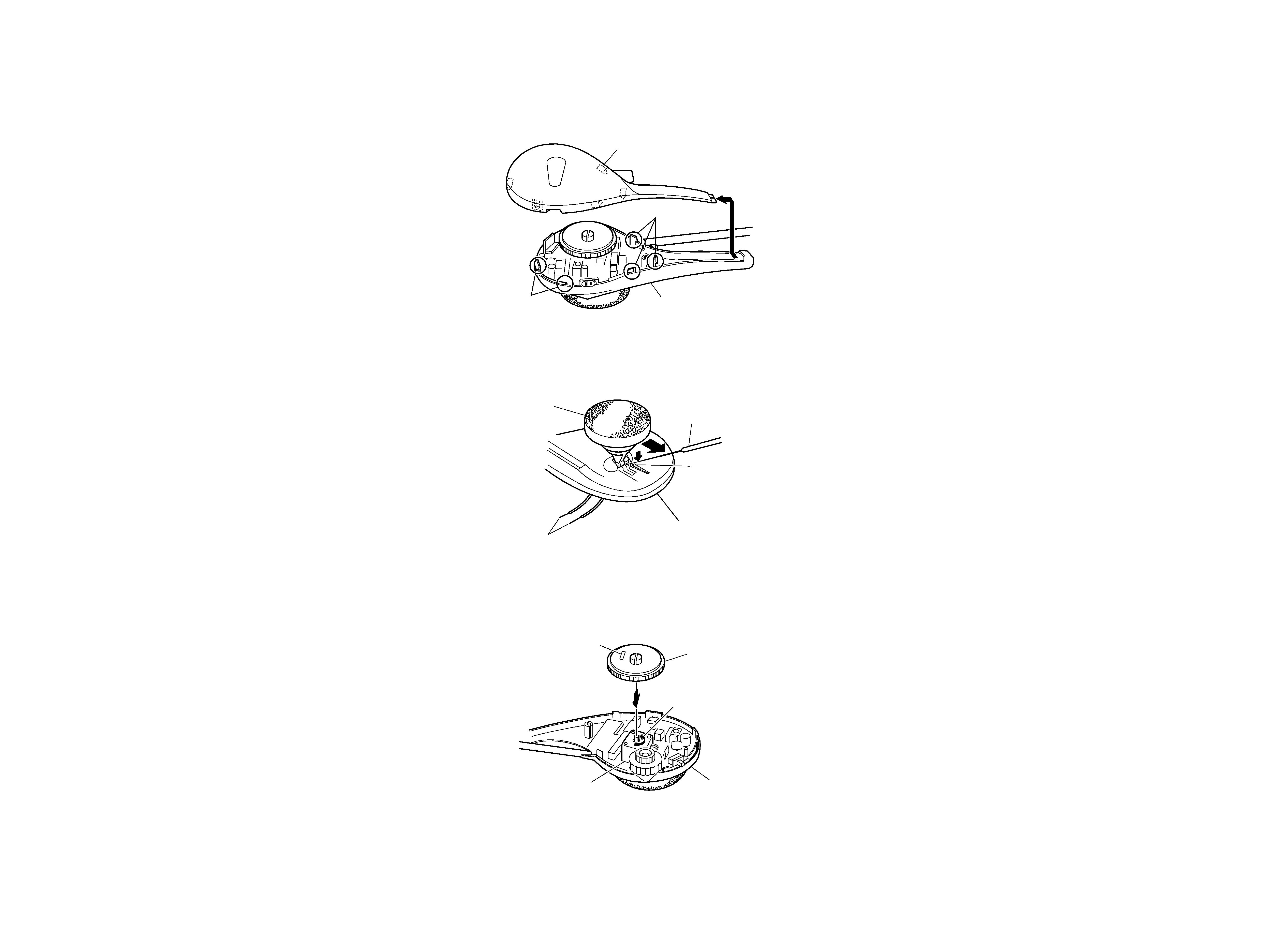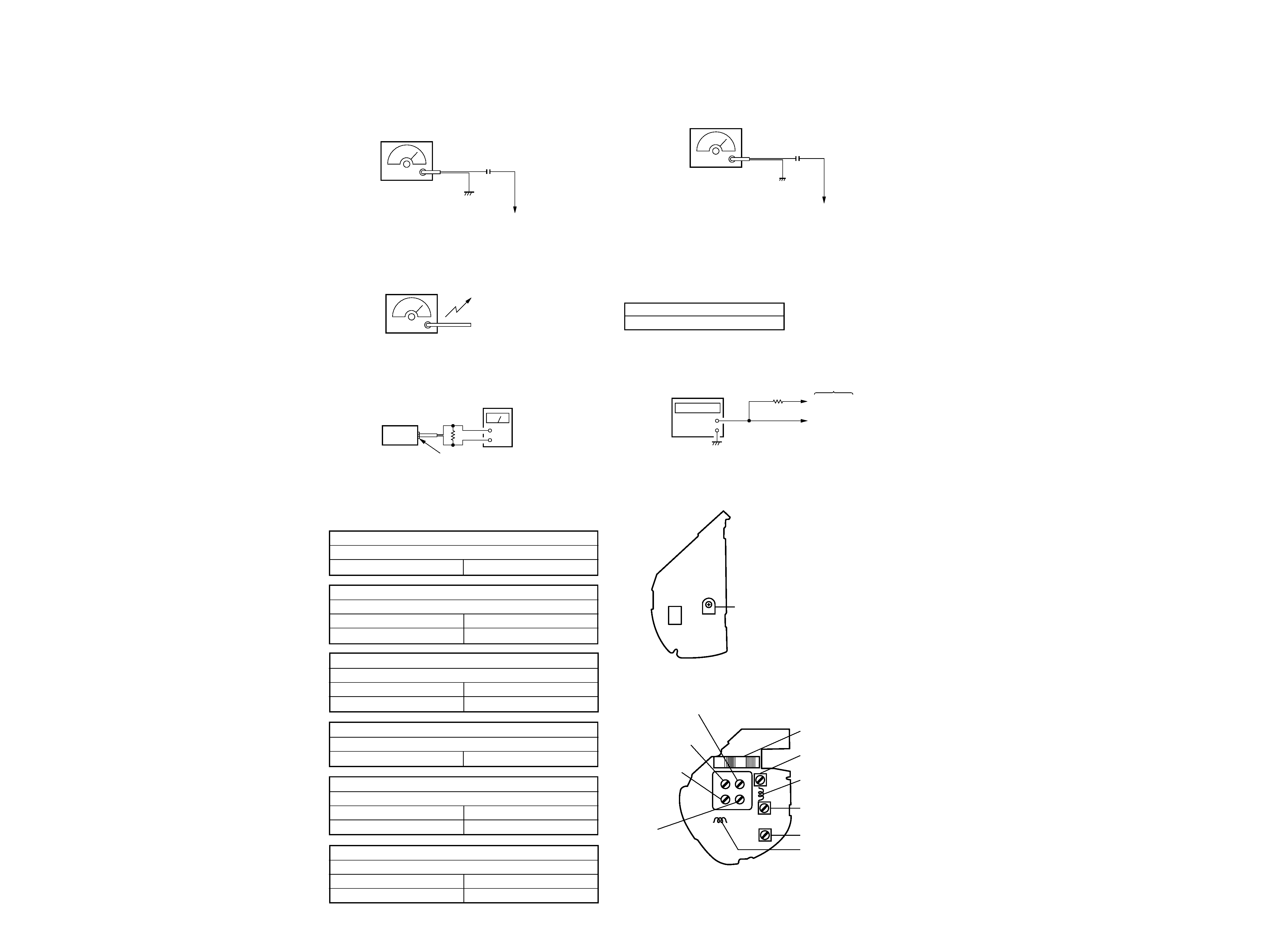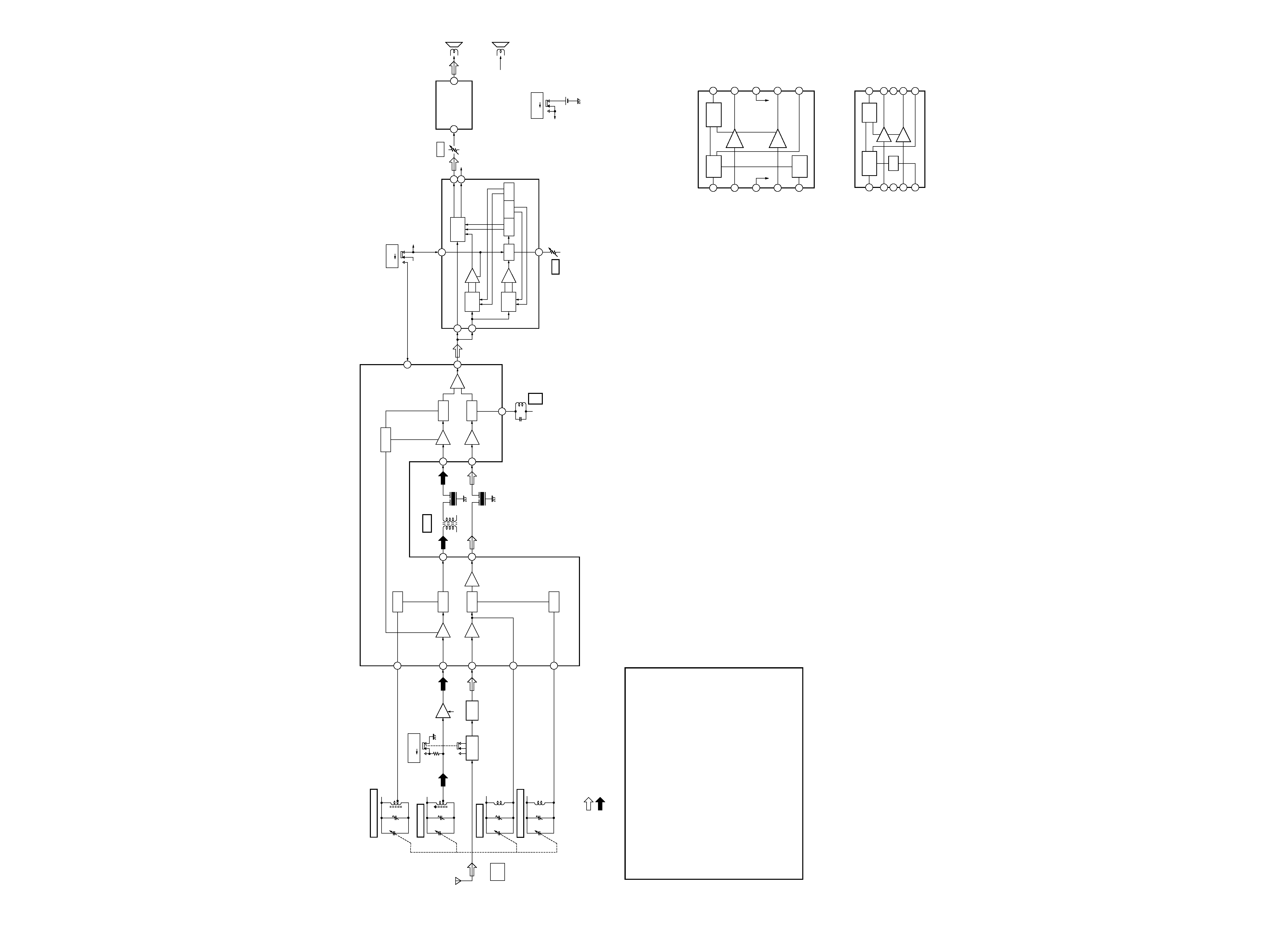
SRF-H3
Australian Model
SERVICE MANUAL
FM STEREO/AM HEADPHONE RADIO
SPECIFICATIONS
Frequency range:
FM: 87.6 108 MHz
AM: 530 1 710 kHz
Power output:
5.0 mW + 5.0 mW (at 10 % harmonic
distortion)
Headphone type:
Dynamic
Power requirements:
1.5 V DC, one size AAA (R03) battery
Mass:
Approx. 132 g (4.7 oz) incl. a battery
Design and specifications are subject to change
without notice.
Ver 1.0 2000. 07

-- 2 --
SECTION 1
GENERAL
Getting Started
Installing the Battery
(See Fig. B)
1 While pressing the battery
compartment lid, slide it to open.
2 Insert one size AAA (R03) battery (not
supplied) with correct polarity.
3 To close the lid, press and slide the lid
down until it clicks.
When to replace the battery
Replace the battery when the sound becomes
weak or distorted. Remove the old battery and
insert a new one.
Battery life (approximate hours)
Sony
Sony
alkaline
size AAA
size AAA
(R03)
(LR03)
FM reception
80
40
AM reception
100
50
Notes on the battery
· Align the battery correctly.
· The dry battery cannot be charged.
· To avoid damage from possible battery
leakage, remove the battery when unit will
not be used for a long time.
Wearing the Radio
1 Pull out the support band fully from
the headband.
2 Adjust the headband and the support
band to fit your head.
Note on the support band
(See Fig. A)
When the radio not in use, put the support band
back by pushing down both ends as illustrated
and push it back underneath the headband.
Note on the light reflector
(See Fig. A)
This reflector reflects a car light at night for your
safety.
Playing the Radio
1 Set POWER to ON.
2 Set BAND to select FM or AM.
For FM, set SENS to LOCAL if interference is
prevalent and reception is too strong. Under
normal condition, set it to DX.
3 Turn TUNE (tuning) to tune in a station.
4 Adjust the volume using VOL.
To turn off the radio
Set POWER to OFF.
AAA (R03) x 1
Head band
Light reflector
FM flexible
antenna
BAND
SENS
VOL
Driver
units
POWER
Support band
Insert the # side of the
battery first.
Battery
compartment
Dial scale
A
TUNE
B
This section is extracted from
instruction manual.
1.
Check the area of your repair for unsoldered or poorly-soldered
connections. Check the entire board surface for solder splashes
and bridges.
2.
Check the interboard wiring to ensure that no wires are
"pinched" or contact high-wattage resistors.
3.
Look for unauthorized replacement parts, particularly
transistors, that were installed during a previous repair. Point
them out to the customer and recommend their replacement.
4.
Look for parts which, through functioning, show obvious signs
of deterioration. Point them out to the customer and
recommend their replacement.
5.
Check the B+ voltage to see it is at the values specified.
6.
Flexible Circuit Board Repairing
· Keep the temperature of the soldering iron around 270°C
during repairing.
· Do not touch the soldering iron on the same conductor of the
circuit board (within 3 times).
· Be careful not to apply force on the conductor when soldering
or unsoldering.
SAFETY CHECK-OUT
After correcting the original service problem, perform the following
safety checks before releasing the set to the customer.

-- 3 --
SECTION 2
DISASSEMBLY
2
Cabinet front (R) assy
Cabinet rear (R) assy
Claws
Claws
1
Precision screwdriver
3
Holder
2
Push this
portion down.
Cabinet rear (R) assy
1
Unsolder two lead wires.
Model name (SRF-H3)
Gear (tuning)
1
Turn CV1 fully in the
direction of arrow.
Cabinet rear (R) assy
CV1
2
2-1. CABINET FRONT (R) ASSY
2-2. HOLDER (WITH DRIVER)
2-3. GEAR (TUNING) INSTALLATION
Note :
Follow the disassembly procedure in the numerical order given.

-- 4 --
SECTION 3
ELECTRICAL ADJUSTMENTS
FM VCO Adjustment
Procedure:
1. Connect the frequency counter to 2 and 1 pins of IC2 as shown
the figure right.
2. Tune the set to 98 MHz.
3. Adjust RV1 for 76 kHz Hz reading on frequency counter.
Specification Value:
FM RF signal
generator
Carrier frequency: 98 MHz
Modulation: no modulation
Output level: 0.1 V (100 dB)
0.01
µF
FM lead wire antenna terminal
Connection:
Adjustment Location:
AM IF ADJUSTMENT
Adjust for a maximum reading on level meter
T1
455 kHz
AM FREQUENCY COVERAGE ADJUSTMENT
Adjust for a maximum reading on level meter
L5
520 kHz
CT1-4
1,650 kHz
AM TRACKING ADJUSTMENT
Adjust for a maximum reading on level meter
L2
620 kHz
CT1-1
1,400 kHz
· Repeat the procedures in each adjustment several times, and the
frequency coverage and tracking adjustments should be finally
done by the trimmer capacitors.
FM IF ADJUSTMENT
Adjust for a maximum reading on level meter
T2
10.7 MHz
FM FREQUENCY COVERAGE ADJUSTMENT
Adjust for a maximum reading on level meter
L4
87.35 MHz
CT1-3
108.05 MHz
FM TRACKING ADJUSTMENT
Adjust for a maximum reading on level meter
L3
87.35 MHz
CT1-2
108.05 MHz
[FM]
Setting:
BAND switch
: FM
[AM]
Setting:
BAND switch
: AM signal
AM RF signal
generator
30% amplitude modulation by
400 Hz signal.
Output level: as low as possible
Put the lead-wire
antenna close to
the set.
FM RF signal
generator
75 kHz frequency deviation
by 1 kHz signal.
Output level: as low as possible
0.01
µF
FM lead wire antenna terminal
level meter
set
SP1, SP2 (speakers)
32
+
Frequency counter
75,500 76,500 Hz
IC2 Pin
2
+
frequency counter
33 k
AUDIO Board
IC2 Pin
1
[AUDIO BOARD] (Component Side)
RV1: MPX VCO
IC2
L2: AM TRACKING
L3: FM TRACKING
T1: AM IF
CT1-4:
AM FREQUENCY
COVERAGE
CT1-1:
AM TRACKING
CT1-2:
FM TRACKING
CT1-3:
FM FREQUENCY
COVERAGE
T2: FM IF
L5: AM FREQUENCY
COVERAGE
L4: FM FREQUENCY
COVERAGE
[TUNER BOARD] (Component Side)

SRF-H3
-- 5 --
-- 6 --
· IC BLOCK DIAGRAMS
IC1 TA7792F
IC3 LA4537M
Note on Schematic Diagram:
· All capacitors are in µF unless otherwise noted. pF: µµF 50 WV or
less are not indicated except for electrolytics and tantalums.
· All resistors are in
and 1/4 W or less unless otherwise specified.
·
f
: internal component.
· A : B+ Line.
· H : adjustment for repair.
· Power voltage is dc 1.5 V and fed with regulated dc power supply
from battery terminal.
· Voltages are dc with respect to ground under no-signal conditions.
· Voltages are taken with a VOM (Input impedance 10 M
).
Voltage variations may be noted due to normal production toler-
ances.
· Signal path.
F:FM
f:AM
Note on Printed Wiring Board:
· X : parts extracted from the component side.
· b : Pattern from the side which enables seeing.
16
BPF
FM RF IN
FM RF
IN
AM IF
IN
FM RF OUT
1
FM OSC
3
AM OSC
4
L2
FERRITE-ROD
ANTTENA
L5
BUFFER
Q1
CT1-1
CV1-1
CV1
TUNE
13
5
14
AM RF IN
AM MIX
OUT
FM MIX
OUT
FM MIX
AM MIX
AM OSC
FM OSC
CF1
12
T1
CF2
7
8
5
13
16
15
2
AM AGC
FM DET
VCO
R-CH
R-CH
RV2
38k
19k<90º 19k<0º
AM DET
AF
OUT
VCC1
R OUT
L OUT
9
RV1
VCO
L3
CT1-2
B+(R16)
B+(R16)
B+(R16)
B+(R16)
CV1-2
FM/AM
FRONT END
IC1(1/3)
STEREO MPX
IC2
SP1
SPEAKER
SP2
SPEAKER
FM:
AM:
ANT1
FM ANT
DX/LOCAL
L4
CT1-3
CV1-3
T2
B+
CT1-4
CV1-4
STEREO
DECODE
11
VOL
6
MPX
MPX
SENS
DX
LOCAL
S1
S1-1
S1-2
9
POWER AMP
IC3
BAND
FM
AM
S2
B+
2
AM B+
AM B+
POWER
OFF
ON
S3
B+
16
· Signal path
FM FREQ. COVERAGE
AM FREQ. COVERAGE
FM TRACKING
AM TRACKING
AM IF
FM
IF
3
MUTE SWITCH
OUT 1
POWER GND
OUT 2
VCC
POWER SWITCH
IN 1
PRE GND
IN 2
REF
POWER
SWITCH
MUTE
CIRCUIT
Amp1
Amp2
BIAS
6
7
8
9
10
1
2
4
5
POWER
SWITCH
MUTE
BIAS
AMP
AMP
1
2
3
4
5
6
7
8
9
10 MUTE
R-OUT
GND
L-OUT
VCC
PWR
R-IN
GND
L-IN
REG
SECTION 4
DIAGRAMS
4-1. BLOCK DIAGRAM
